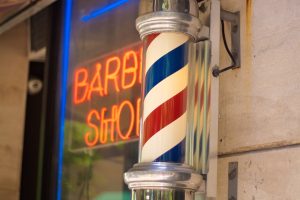Unraveling the Barber Pole: Its Rich History & Color Significance in Barbering
The Fascinating History of the Barber Pole and the Significance of its Colors
Barbershops are a fixture in communities worldwide. While the tools, techniques, and trends have evolved, one symbol remains deeply rooted in the identity of the barbering profession: the barber pole. This seemingly simple symbol, typically characterized by its spiraling red, white, and blue colors, holds a rich and intriguing history that dates back to the Middle Ages.
The Birth of the Barber Pole: Medieval Times
To understand the origins of the barber pole, we need to journey back to a time when barbers did more than just cut hair. During the Middle Ages in Europe, barbers often performed surgical procedures, a task that might seem unimaginable today. They were commonly known as “barber-surgeons.”
The services provided by these barber-surgeons varied from tooth extractions to bloodletting – a once-popular belief that draining “bad blood” could cure ailments. For bloodletting, barbers would use leeches or make incisions. Patients would grip a rod or a pole during the procedure, which would encourage blood flow.
After the procedure, the stained bandages, showcasing red (blood) and white (bandages), were washed and hung to dry on the pole outside the shop. Over time, this became an advertising strategy, informing potential clients of the services offered within.
Transition to Modern Barbering and the Incorporation of Blue
As time progressed, the medical community began to separate from the barbering profession, leading to distinct roles: physicians who dealt with internal ailments and surgeons who dealt with external traumas and issues. Eventually, the British Parliament passed an act in 1745 that officially distanced surgeons from barbers. However, the association between barbers and their historical surgical role persisted, symbolized by the barber pole.
While red and white were the original colors, blue was added in the United States. There are various theories regarding the incorporation of blue. Some believe it was an homage to the national colors of the U.S. (red, white, and blue). Others postulate that the blue might represent venous blood, contrasting the red’s representation of arterial blood.
Symbolic Interpretations

A photo showcasing the historical evolution of barbershop entrance designs
- Red: As mentioned, the red traditionally symbolizes blood. This serves as a reminder of the barber-surgeon’s role in bloodletting and other surgical procedures.
- White: The white stripe, historically, represents the bandages used during surgical procedures, both as a tool and post-operation.
- Blue: While its origins are debated, the blue is thought to represent venous blood or simply be an American adaptation to align with national colors.
A Timeless Emblem in Modern Barbering
Today, while barbers no longer perform medical procedures, the barber pole remains an iconic symbol of the profession. It’s a nod to the rich history and the evolution of the trade. The pole stands as a beacon, signifying trust, tradition, and the timeless craft of barbering.
In essence, the barber pole is not just a decorative piece or mere advertisement; it’s a testament to the resilience and transformation of the barbering profession, reminding us of the intricate tapestry of history, service, and community that barbershops have woven over centuries.
Related Posts
The Timeless Tapestry: Unraveling the Art of Barbering
Barbering, a craft as ancient as civilization itself, is more than just the snipping of hair or the trimming of beards. It’s an art form that has evolved through centuries, intertwined with cultural, societal, and historical shifts. At its core, barbering is about understanding people, their stories, and translating that into a style that best […]
Barbering & Cosmetology: The Heart and Soul of San Diego’s Vibrant Culture
San Diego, the jewel of Southern California, pulses with an unmatched vibrancy, which can be traced from its sun-kissed beaches to its bustling downtown streets. But there’s another factor that weaves into the city’s rich tapestry: the profound influence of barbering and cosmetology. Barbering: A Historical Perspective in San Diego Barbering isnR
Why a Hot Shave Makes All the Difference for a Man
In the world of male grooming, few experiences compare to the luxurious and transformative effect of a hot shave. This traditional barbering ritual, often seen as a throwback to a bygone era, offers a plethora of benefits that go beyond mere facial hair removal. Let’s delve into why a hot shave is more than just […]
Barbershops and Kids: The Unforgettable Impact Barbers Have on Our Youth
The barbershop experience is about so much more than just a haircut. For children, it’s a rite of passage, a place where confidence is built, traditions are passed down, and bonds are formed. Barbershops, often seen as community hubs, play an important role in shaping the lives of young people. From their first haircut to […]




